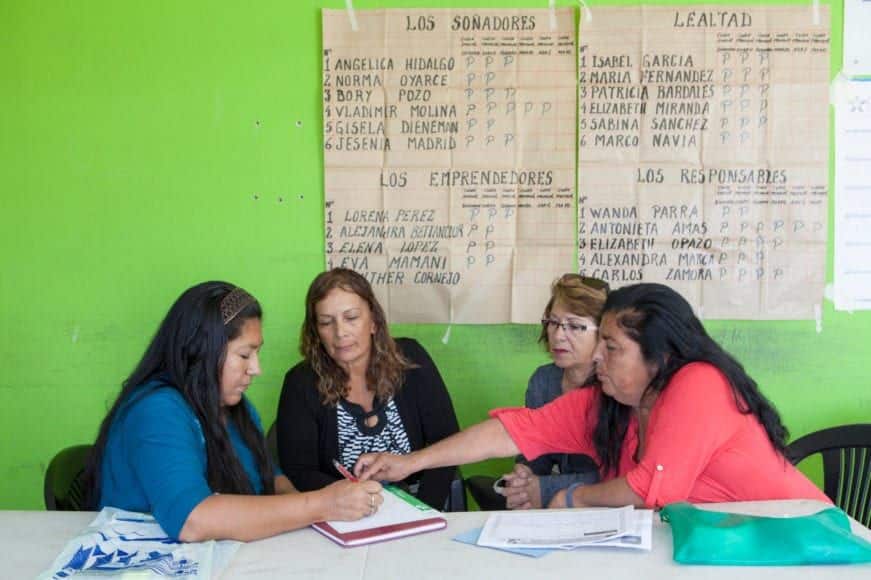To alleviate poverty on a large scale is serious business. There is nothing funny about the living conditions of too many people around the world who struggle to make ends meet for themselves and their families. However, despite its popular connotation implying having fun, the word ‘game’ has at least two forms which show how a game can be practical and productive: Game Theory and Gamification.
In this blog post, we examine how Game Theory and Gamification can advance the higher purpose of microfinance in reducing poverty for people living all over the world. Our team’s unique experience meeting partners across four regions and 77 countries gives us insights into ways our microfinance partners employ these two concepts in their work to reach people living in poverty. It may not all be fun and games… but there are times when it clearly should.
Photo at the top of this post: Microloan borrower-group members, collaborating and learning via gamelike activities, at Whole Planet partner Fondo Esperanza’s remote Atacama Desert branch in Calama, Chile.
Gamification
Merriam-Webster defines gamification as “the process of adding games or gamelike elements to something (such as a task) so as to encourage participation.”
In our field travels for Whole Planet Foundation, visiting partner microfinance institutions (MFIs) we often see gamification applied in various, creative ways to help educate borrowers and field officers. Games are used not only to encourage participation in solidarity loan programs, but in other areas such as preventative healthcare; small-business accounting, marketing, and sales best practices; soft skills training; and conflict resolution techniques.
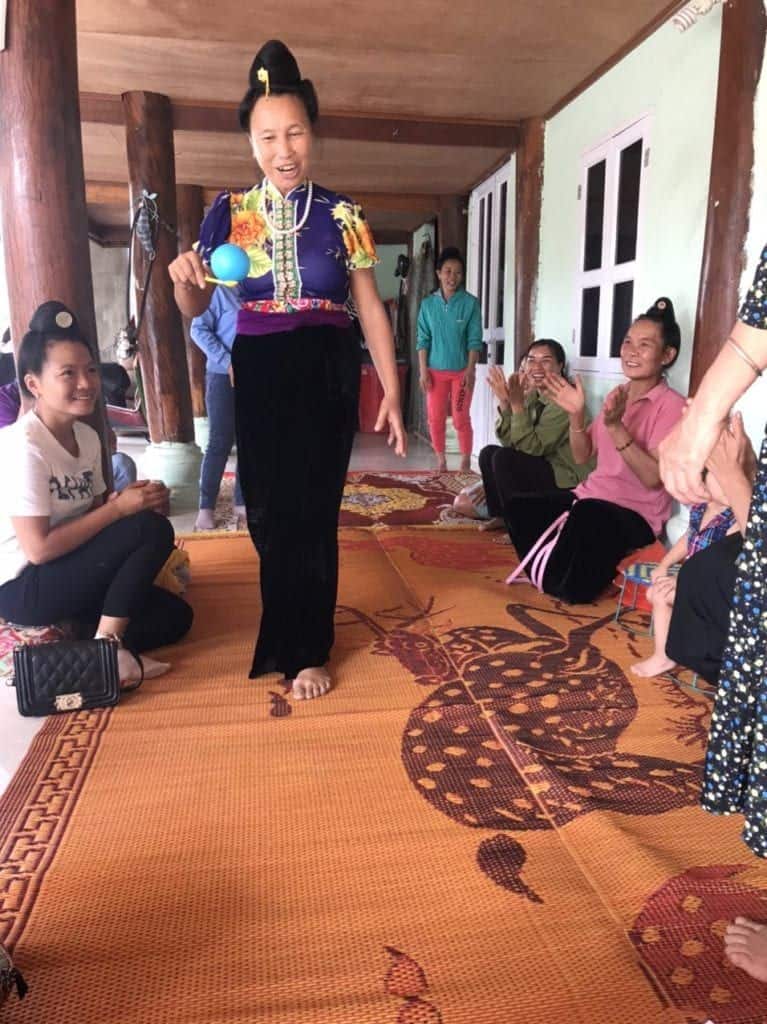
At a group meeting of WPF partner Anh Chi Em, clients have a contest about balancing different sized balls on a spoon to demonstrate the importance of taking an appropriate/manageable loan size.
Gamification in Colombia
Whole Planet Foundation supports an innovative partner in Colombia called Aflore. We provide them with microloan capital specifically for their operations in the municipality of Medellin. During a monitoring and evaluation trip to Medellin in 2019, I learned of an educational tool the Aflore team developed there for both their Independent Advisors (IAs) and borrowers. It is a board game they call Juego Financiero (Financial Game), designed to teach basic finance concepts and important Aflore-specific information, by simulating a small town and its economy. In order to advance toward winning the game, one must answer questions correctly, such as “Where/how can a borrower make their monthly repayment installments?”, “What are the loan requirements for a retired person?” and “What is the monthly interest rate charged by Aflore?”
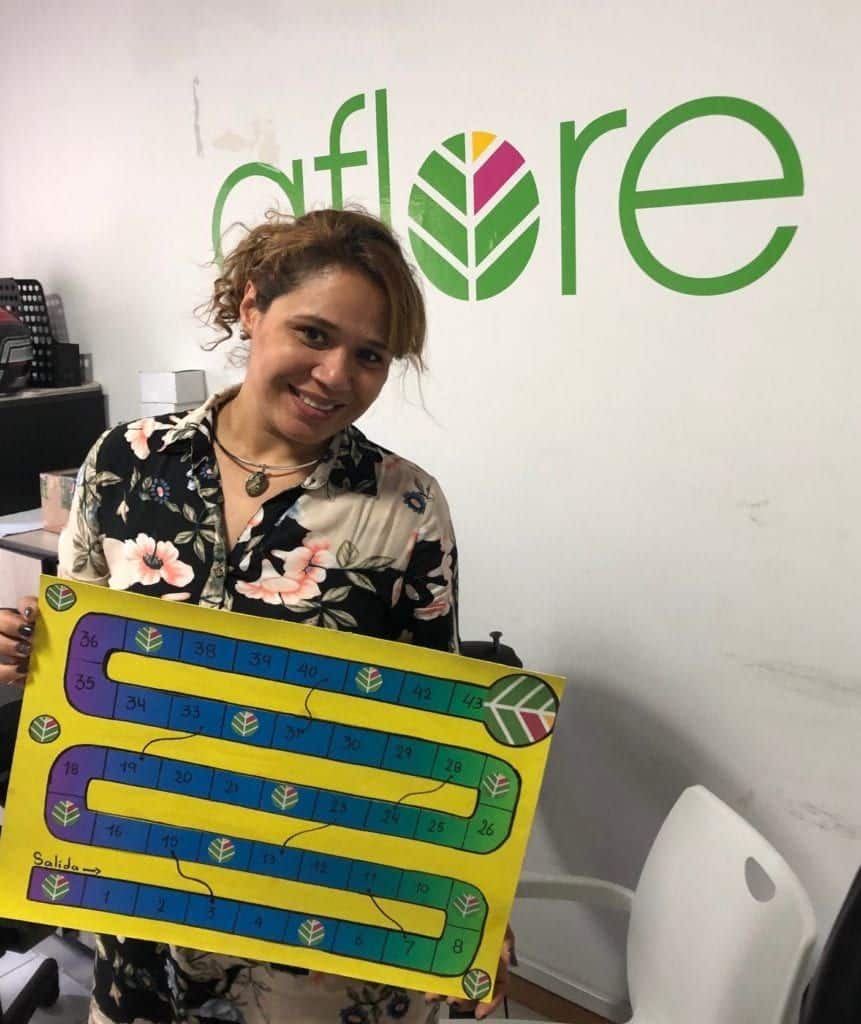
An Aflore Independent Advisor, holding up the Juego Financiero board game.
Aflore has also created and continues to deploy online tools which are accessed by their lender/borrower community, mainly via smartphones. During a meeting with web developers at the Aflore headquarters in Bogota, I learned of their objective to increasingly utilize gamification via social media such as Facebook, and through their internally developed application called Mi Aflore (My Aflore). One example is to ensure IAs’ continued focus on helping their peers and neighbors as a primary motivation, while also providing the IAs with incentives to help grow their borrower base and improve loan repayment rates. The incentives are given in the form of points called Florines, the accumulation of which is tied to repayments, loans granted, and potential new-borrower referrals. IAs can exchange accumulated points for items such as home appliances, apparel, and cash.
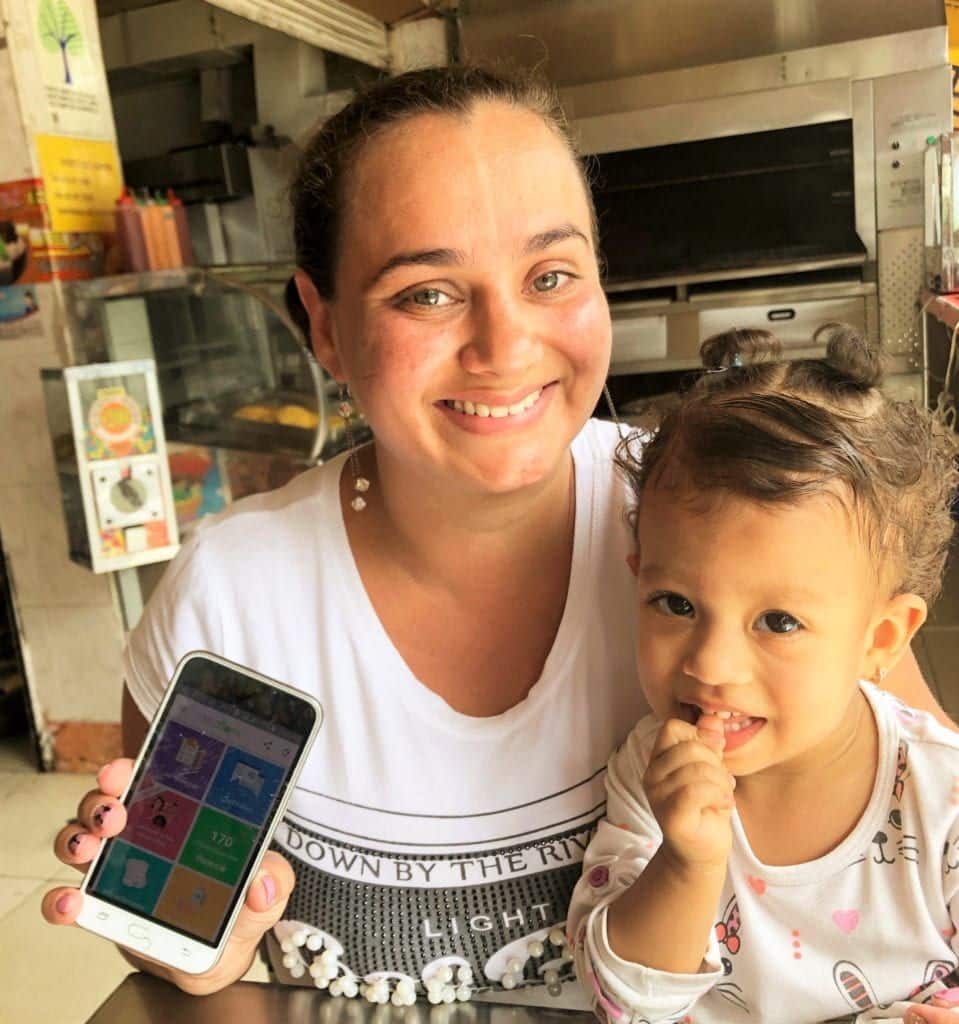
An Aflore Independent Advisor in Colombia showing the Mi Aflore app on her smartphone.
Games around the Globe
In Africa, One Acre Fund (OAF) is a long-standing Whole Planet partner and leader in the global agricultural finance space. We have supported them in Burundi, Kenya, Rwanda, Tanzania, and Zambia. Recognizing the effectiveness of gamification, OAF aims to keep all their field staff trainings interactive by using what they call “Active learning Strategies.” Many of the training modules they have developed utilize gamelike activities related to areas such as , Work Planning, and Repayment Activity. One game they have adapted to deliver their training is Bingo. OAF trainers have field staff play with a card with questions like “I am always able to complete my tasks at work and at home,” or “I never have enough time with my family.” Players/trainees are asked to walk around and find other staff who share each experience on their Bingo card. This helps them build relationships and share strategies on how to achieve work/life balance.1
In many of our program countries, we observe games being used to engage both staff and borrowers alike – to provide meaningful training as well as healthy competition toward individual and group goals. Here are a few photos to illustrate these games:
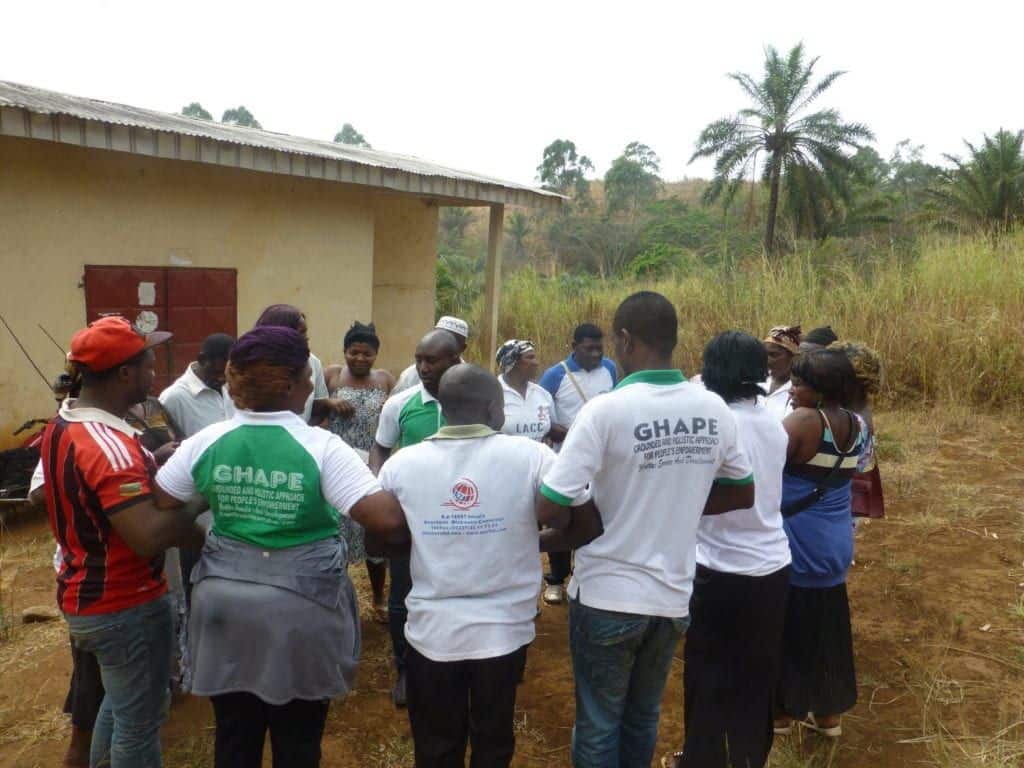
In Cameroon, our MFI partner GHAPE employs a new client training which involves a trust fall exercise to simulate the solidarity required of group members.
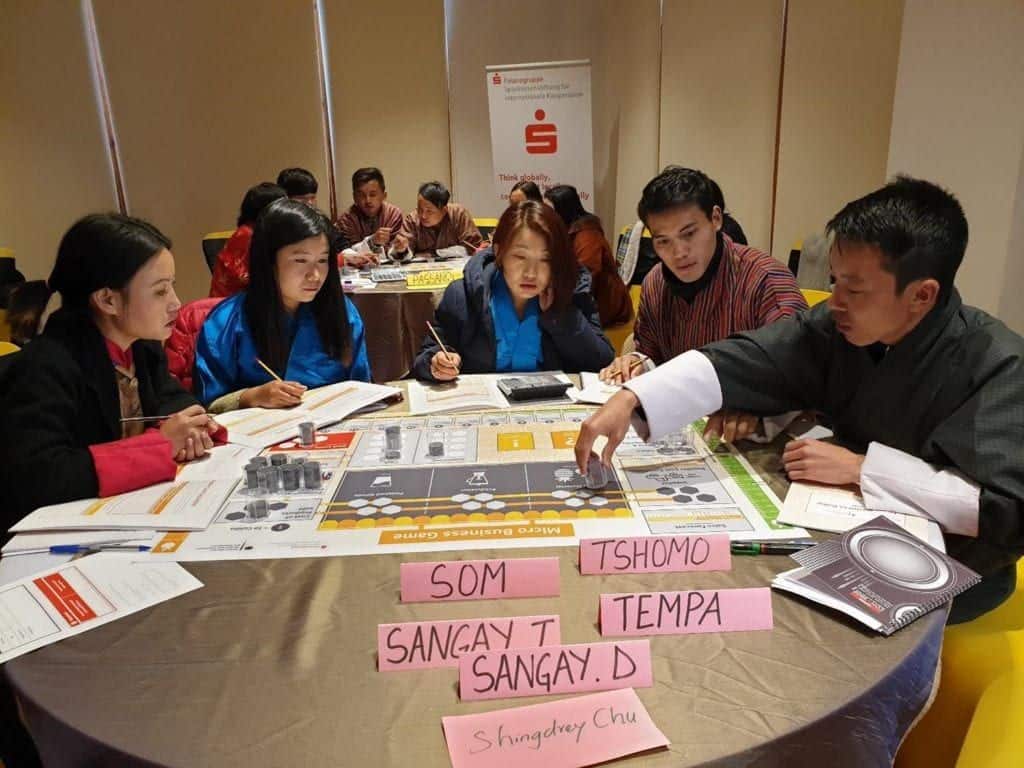
RENEW MFI staff participate in a classic SBFIC “microbusiness game” in Bhutan. The participants learn to manage a company (juice production). It’s about market inclusion, forecasting, balance sheet and profit and loss.
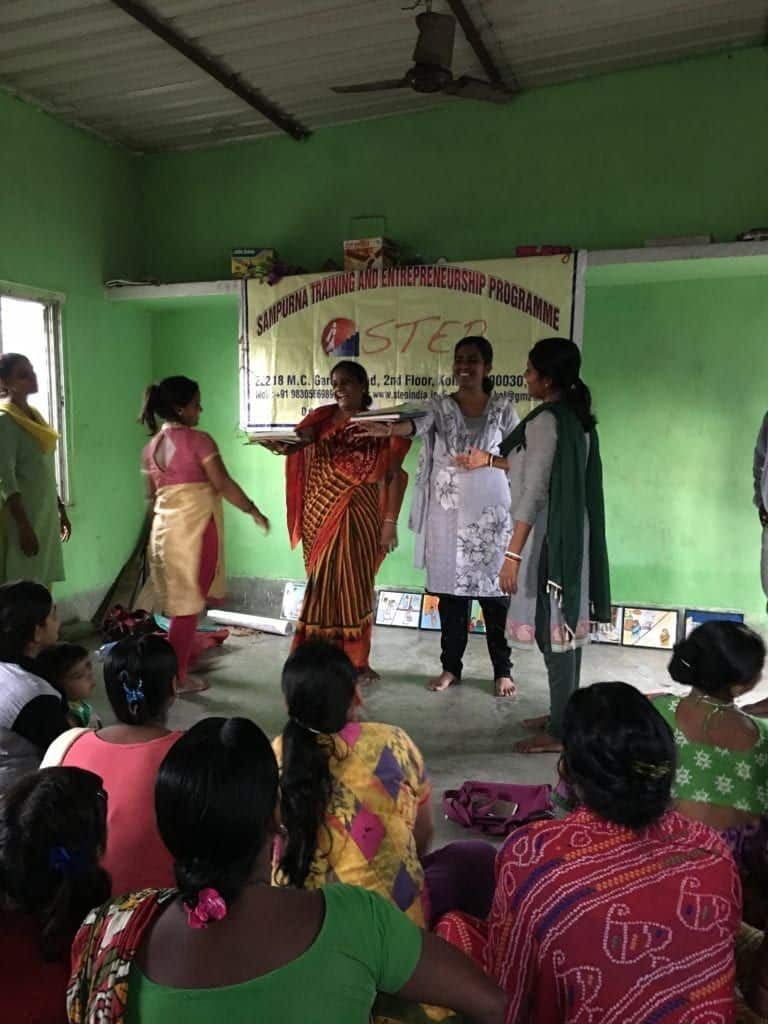
Our microfinance partner in India, STEP, holds community outreach trainings which includes a striking example of the dangers of over-indebtedness.
Game Theory
Albeit greatly reduced over the last several decades, why does poverty persist at such high levels across the globe? How can we buck the trend of slower progress than we’d like ( for 2015, the results of which prompted the new, revised Sustainable Development Goals for 2030), and even reversals in progress due to disrupting factors like the current coronavirus pandemic?
The problem of global, persistent poverty requires a multifaceted solution, involving both large, institutional ‘macro’ efforts and more localized, ‘grassroots’ initiatives. One very useful tool at both these levels is the branch of economics called Game Theory.
Merriam-Webster defines Game Theory as “the analysis of a situation involving conflicting interests (as in business or military strategy) in terms of gains and losses among opposing players.”
Dr. Bruce Wydick, in the preface of his book, Games in Economic Development, offers a clear, concise description of what game theory is and how it is useful in many areas, including microfinance:
“Game theory is a formal structure used to understand human interaction. Because human interaction is both frequent and desirable for most of us, game theory covers a lot of ground: Games occur in social relationships, during market exchange, in the fulfillment of contracts, in the use of environmental resources, in educational and technology choices, in politics, and myriad other aspects of everyday life. By analyzing human interaction in a formal structure, game theory can make predictions about how people will behave and the consequences of their behavior. This makes game theory a powerful tool. It can also give us insight into difficult questions, such as why some countries have become rich and others remain poor.
… The study of economic development is essentially the study of how multiple outcomes in economies may arise, some better than others… changing the incentives and rules of the game by which society operates can dramatically affect the outcome of the game and the resulting welfare of its players, creating a basis for either poverty or prosperity.2
Game Theory in Peru
So how can game theory be applied to and help the work of microfinance institutions in reducing poverty? Some insight into this can be found in a paper titled Microfinance Games published by the Economic Growth Center of Yale University. 3 The authors recognize that over the past few decades, microfinance has transformed thinking about banking in low-income communities, and that techniques used to achieve high loan repayment rates contain many overlapping mechanisms. They studied this by running an experiment in a large urban market called Polvos Azules, located in the center of Lima, Peru. Over the course of seven months, they conducted eleven different “games” which allowed them to carefully analyze existing microfinance mechanisms.
The study’s focus was on group-based lending, which is the primary model of microfinance supported by Whole Planet Foundation. One of the main concepts with these group-based credit mechanisms is that joint borrower liability reduces defaults on group members’ loans, since they can bail each other out if one of their businesses is unsuccessful and a borrower is unable to repay on their loan. This helps the lender’s success and gives them incentive to make successive loans to their borrowers, and to lend to new borrowers as well.
While the study also revealed some unintended consequences in the practice of solidarity group lending, the authors also found there are corrective measures such as allowing borrowers to self-select when forming groups, to help mitigate risky behavior.
Game Theory in the Philippines
In an evaluation by the Asian Development Bank posted in The Catholic Economist, game theory is used to analyze conflicts between the poor and microfinance institutions in the Philippines. They specifically look at the issue within a framework of the Extensive Form game, which is a way of describing a game using a game tree.4, 5
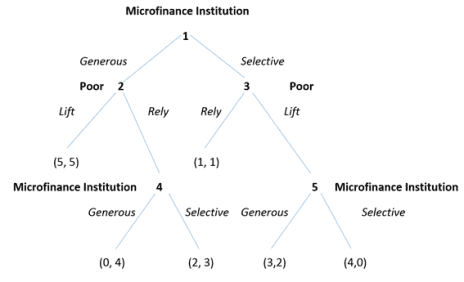
No Silver Bullet
Whole Planet Foundation’s President and Executive Director, Philip Sansone, has often asserted that microfinance is not a single “silver bullet” which will eradicate poverty worldwide, and as Professor Wydick also suggests, the solution is rather a multi-pronged approach which includes establishing and maintaining effective, resilient institutions to safeguard property rights, reduce corruption, establish and ensure adherence to the rules of the game (pun intended) in international trade… all to justly and properly serve the poor and offer them a true opportunity for a better livelihood for themselves and their families.
No, it’s most certainly not all fun and games, but even fun and games — applied at the right time and in the right way — can be valuable tools to help us move more quickly and ever closer towards sustained well-being for all.
References
1 Courtesy of Cathy Mbithi, Senior Associate, Business Development, One Acre Fund, Nairobi, Kenya
2 Wydick, Bruce. Games in Economic Development. New York, Cambridge University Press, 2008.
3 Giné, Xavier; Jakiela, Pamela; Karlan, Dean; Morduch, Jonathan. Microfinance Games. New Haven, Yale University Economic Growth Center, 2006.
4 Lambitco, Bea; Santos, James; Baritua, Raymond. Microfinance and Poverty Alleviation in the Philippine Context: A Game-Theoretic Look. Manila, Ateneo De Manila University, 2014.
5 Some other forms in the field of game theory are the Prisoner’s Dilemma, the Principal-Agent Model, Nash Equilibria, and the Winner’s Curse. The application of the Winner’s Curse phenomenon in the expansive and ever-evolving field of auctions, was fundamental to the work which earned Paul Milgrom and Robert Wilson the 2020 Nobel Prize in Economic Sciences.

